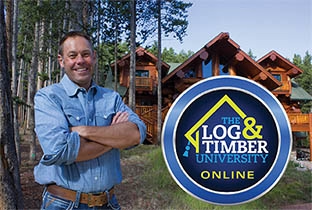Compiled by Katherine Owen
Photos courtesy of Dwight Kroll
Step inside the creative renovation of reader Dwight Kroll, who transformed a 1980s, 1,200-square-foot cabin into a 1,900-square-foot studio and bunkhouse.
Dwight: I live in central California, and I used to do a bunch of rock climbing, so I would often travel up into the Western Sierra. From my drive along the highway, I watched this log cabin being built. It was a little place built by Real Log Homes, and it really caught my fancy.
One day as I came around the bend, I was surprised to see an open house sign there. I pulled up and walked in. I thought, “This is my place. I’m going to buy this,” even though I didn’t know anything about log cabins and wasn’t house shopping. It just felt like coming home.
As many know, log home ownership can come with a learning curve; even trying to get financing for something like this was difficult. However, with help from a representative from Real Log Homes, I was able to obtain a loan, and I bought the place. I was a single guy then and loved living there. Then I became un-single.
Eventually, the cabin became too small for us, and it also needed some serious maintenance and renovation. I think, like a lot of log homeowners, one is attracted to the coolness or the cuteness initially and then you realize, man, this is a whole different thing to take care of. You have to stay on top of it. You can’t let it languish. The cabin finally got to the point that something had to be done to save it.
So I bought the house next door, and we moved in. Then for the log house we thought, “Let’s try something a little different.”
Having traveled around the Sierras, I have seen all sorts of examples of historic mining architecture; places that were initially log structures that got added onto with metal, stone and whatever else could be found. I thought that characteristic seemed very authentic. So rather than continue with a log addition, we decided to change up the architecture some, thinking that it’ll give it a little bit of design tension but also reflect authentically. Once we went down the path of adding corrugated metal and log posts, it occurred to us that this kind of design is reminiscent of Japanese architecture as well, with the logs standing up on their ends.
Inside, we took a little bit of a different tactic and decided to mix in some mid-century elements. A lot of mid-century design is about making things simple — more about extracting rather than adding. It was perfect and harmonized well with the new exterior.
We were going to Airbnb this place, but we like it so much that we made it a guesthouse for friends and family and my studio office. We live beside ourselves, and we love it!















